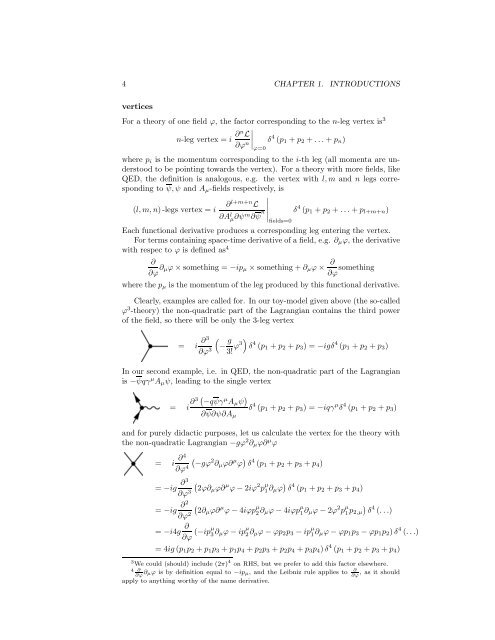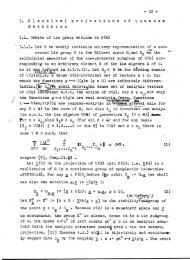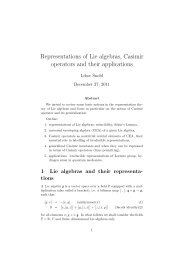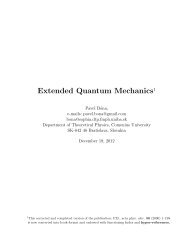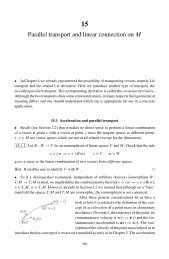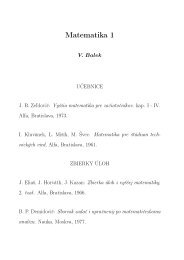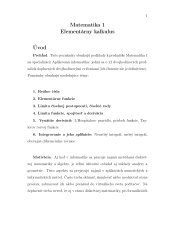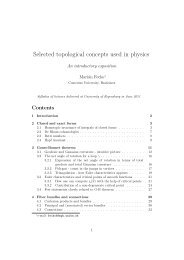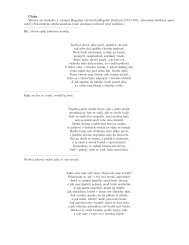Quantum Field Theory I
Quantum Field Theory I
Quantum Field Theory I
Create successful ePaper yourself
Turn your PDF publications into a flip-book with our unique Google optimized e-Paper software.
4 CHAPTER 1. INTRODUCTIONS<br />
vertices<br />
For a theory of one field ϕ, the factor corresponding to the n-leg vertex is 3<br />
n-leg vertex = i ∂n L<br />
∂ϕ n ∣<br />
∣∣∣ϕ=0<br />
δ 4 (p 1 +p 2 +...+p n )<br />
where p i is the momentum corresponding to the i-th leg (all momenta are understood<br />
to be pointing towards the vertex). For a theory with more fields, like<br />
QED, the definition is analogous, e.g. the vertex with l,m and n legs corresponding<br />
to ψ,ψ and A µ -fields respectively, is<br />
(l,m,n)-legs vertex = i<br />
∂ l+m+n L<br />
∂A l µ∂ψ m ∂ψ n ∣<br />
∣∣∣∣fields=0<br />
δ 4 (p 1 +p 2 +...+p l+m+n )<br />
Each functional derivative produces a corresponding leg entering the vertex.<br />
For terms containing space-time derivative of a field, e.g. ∂ µ ϕ, the derivative<br />
with respec to ϕ is defined as 4<br />
∂<br />
∂ϕ ∂ µϕ×something = −ip µ ×something+∂ µ ϕ× ∂<br />
∂ϕ something<br />
where the p µ is the momentum of the leg produced by this functional derivative.<br />
Clearly, examples are called for. In our toy-model given above (the so-called<br />
ϕ 3 -theory) the non-quadratic part of the Lagrangian contains the third power<br />
of the field, so there will be only the 3-leg vertex<br />
¡=i ∂3<br />
∂ϕ 3 (<br />
− g 3! ϕ3) δ 4 (p 1 +p 2 +p 3 ) = −igδ 4 (p 1 +p 2 +p 3 )<br />
In our second example, i.e. in QED, the non-quadratic part of the Lagrangian<br />
is −ψqγ µ A µ ψ, leading to the single vertex<br />
¡=i ∂3( −qψγ µ A µ ψ )<br />
∂ψ∂ψ∂A µ<br />
δ 4 (p 1 +p 2 +p 3 ) = −iqγ µ δ 4 (p 1 +p 2 +p 3 )<br />
and for purely didactic purposes, let us calculate the vertex for the theory with<br />
the non-quadratic Lagrangian −gϕ 2 ∂ µ ϕ∂ µ ϕ<br />
¡=i ∂4<br />
∂ϕ 4 (<br />
−gϕ 2 ∂ µ ϕ∂ µ ϕ ) δ 4 (p 1 +p 2 +p 3 +p 4 )<br />
= −ig ∂3 (<br />
2ϕ∂µ<br />
∂ϕ 3 ϕ∂ µ ϕ−2iϕ 2 p µ 1 ∂ µϕ ) δ 4 (p 1 +p 2 +p 3 +p 4 )<br />
= −ig ∂2 (<br />
2∂µ<br />
∂ϕ 2 ϕ∂ µ ϕ−4iϕp µ 2 ∂ µϕ−4iϕp µ 1 ∂ µϕ−2ϕ 2 p µ 1 p )<br />
2,µ δ 4 (...)<br />
= −i4g ∂<br />
∂ϕ (−ipµ 3 ∂ µϕ−ip µ 2 ∂ µϕ−ϕp 2 p 3 −ip µ 1 ∂ µϕ−ϕp 1 p 3 −ϕp 1 p 2 )δ 4 (...)<br />
= 4ig(p 1 p 2 +p 1 p 3 +p 1 p 4 +p 2 p 3 +p 2 p 4 +p 3 p 4 )δ 4 (p 1 +p 2 +p 3 +p 4 )<br />
3 We could (should) include (2π) 4 on RHS, but we prefer to add this factor elsewhere.<br />
4 ∂<br />
∂<br />
∂µϕ is by definition equal to −ipµ, and the Leibniz rule applies to , as it should<br />
∂ϕ ∂ϕ<br />
apply to anything worthy of the name derivative.


